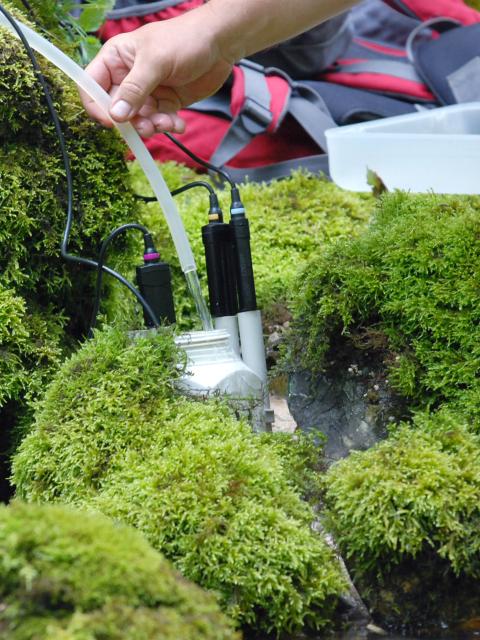Karst spring monitoring
Duration: since 1991 continuously extended monitoring
Project operator: Nationalpark O.ö. Kalkalpen Ges.m.b.H.; since 1999 with financial support from the European Union (LIFE sub-project)
Task
Karst spring monitoring" is the hydrological focus program of Kalkalpen National Park. It combines a series of hydrological and hydrobiological investigations as part of concerted, synoptic measurement campaigns. Karst spring monitoring was started in 1991, after an overview of the area's hydrology had become possible on the basis of spring mapping. The program has three central questions:
- To gain knowledge about the hydrogeological and ecological status of the national park catchment areas by recording the output, the sources, under seasonal and long-term conditions. This also included long-term faunistic observations (emergence traps);
- to investigate the processes that take place in the springs during frontal passages and floods, but also during calm low-water phases. This highly interdisciplinary approach forms the link to the permanent recordings of the digital karst water measuring stations (Hydrographic Service of the Province of Upper Austria);
- to compile basic data on hydrochemistry, hydrography, organic and turbidity loads and isotope hydrology; in parallel, initial surveys of spring ecology, biodiversity and abundance in the sources.
- The "Karst Spring Monitoring" campaigns are carried out seasonally with parallel single measurements, usually four times a year. They cover around 40 larger springs from a total sample of almost 800 known springs. From 1991 to 2000, a total of 34 such campaigns took place.

The "event campaigns" have been running since 1995 and monitor 2 to 3 selected springs and some tributaries in their catchment areas at very close intervals (every three to six hours) during certain weather conditions (in particular heavy precipitation events and snowmelt). Also since 1995, several faunistic studies have been carried out with special consideration of ecological indicators and species relevant to nature conservation (Weigand 1999, Haase et al. 2000). Since 1997, the spring campaigns have been laid down as a task in the ordinance text (LGBL LÖ, Jg. 1997, 67. Stück, Nr. 113, dated 24.9.1997) to the National Park Act 1997 under I. Section §2.
In 1999, this proven environmental monitoring program was considerably expanded. The now standardized investigation program was extended to the working areas of the LIFE management project , so that in 1999, including the first preservation of evidence, 351 complete analysis sample units from a total of 127 sources were anchored in the laboratory database. Furthermore, in 2000 a standardized monitoring procedure was installed using the emergence trap technique to record selected bioindicators (aquatic insects) (Haseke et al. 1999, Haseke 2000). Particular attention was paid to the sources of the National Park alpine past ures, with one sample being taken immediately before the alpine pasture upwelling and one immediately after the downwelling.
Summary
the results to date
Qualitative situation of the spring water in Kalkalpen National Park: The hydrochemical quality of the water in Kalkalpen National Park generally corresponds to clean drinking water conditions. Only individual local sites, particularly in the northern areas, always have slightly higher nitrate levels from alpine pastures and agriculture. However, all values remain below the applicable limits and almost always below the WHO recommendations. Microbial pollution and that caused by turbidity , on the other hand, is significantly higher in many places and requires action from a hydrological perspective.
By and large, the spring waters examined as part of the current LIFE project show the typical pattern in the national park mentioned above.
It is interesting to note that even small springs on currently grazed alpine pastures hardly have higher nutrient levels than many forest springs. This may indicate the functioning circular economy of alpine pasture management in the national park (no additional fertilization, etc.). Microbiologically, however, the water is consistently contaminated to highly contaminated and the supply to the alpine huts is also affected. Systematic remediation of the drinking water problems in the area began in 2000.
Contact:
Elmar Pröll, Nationalpark Oö. Kalkalpen Ges.m.b.H. elmar.proell@kalkalpen.at
Dr. Erich Weigand, Nationalpark Oö. Kalkalpen Ges.m.b.H. erich.weigand@kalkalpen.at
Dr. Harald Haseke, Salzburg
Current Reports & Publications
HASEKE, H. & E. PRÖLL (1999): Karst spring monitoring 1998 - National Park Karst Program. Final report, 77 p. - Unpublished study on behalf of the Nationalpark O.ö. Kalkalpen Ges.m.b.H.
HASEKE, H. (2000): Hydrobiological and microbiological analyses and preservation of evidence at the springs - preliminary report 1999 (section F2). Working report within the framework of the LIFE project "Management of natural forests in the Kalkalpen National Park (LIFE99NAT/A/5915)". - Unpublished study on behalf of the Nationalpark O.ö. Kalkalpen Ges.m.b.H.
MENNE, B. (2000): Spring monitoring and LIFE project in the Kalkalpen National Park. Assessment of the results of 1999 from a karst microbiological point of view. 16 p., 11 fig. - Unpublished. Report on behalf of Kalkalpen National Park, Mühlacker, July 2000.
WEIGAND, E. (1999): Biodiversity in alpine karst spring systems (Kalkalpen National Park, Austria). Deutsche Gesellschaft für Limnologie (DGL), Tagungsband 1998 (Klagenfurt), Tutzing 1999, Vol. I, 149-153.
HAASE, M., E. WEIGAND & H. HASEKE (2000): Two New Species of the Family Hydrobiidae (Mollusca: Caenogastropoda) from Austria. The Veliger 43(2): 179-189.
HASEKE, H. & E. WEIGAND (2000): Life in subterranean waters of the Rettenbach Cave. Mitt. des Landesvereins für Höhlenkunde in Oberösterreich, 46. Jg. - 2000/1, 105, 14-38.



